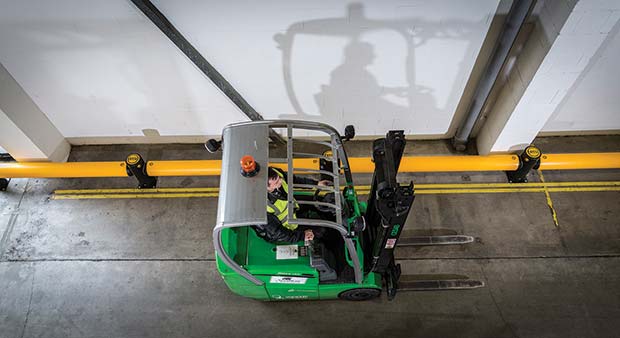Examining the Carbon Footprint of Steel Safety Barriers against Polymer Safety Barriers.

There was a time when companies didn’t really have a choice on the type of barrier they implemented in their facility.
If a manager decided there was a need for a barrier – say, for protection, or segregation, or guidance – it usually meant a trip to the local steel fabricators with a pencil drawing, a few measurements and a request for them to ‘knock something up’.
When the Armco-type barrier arrived it was then a case of casting and bolting it into a slab of concrete and standing back and admiring the work… until a forklift truck hit it.
When steel is impacted, it is strong, but it is also rigid and inflexible. These inherent characteristics mean impact energies are not absorbed by the metal, but instead travel downwards into those fixtures and fittings – and, if the impact is strong enough, ripping out the barrier from the floor and ruining that expensive slab of concrete.
As well as a new floor and a replacement for the crumpled barrier, the manager would likely need a new forklift truck. He would also suffer a long period of facility downtime and possibly need to replace an injured vehicle driver.
Polymer barriers are different.
While still strong, they also flex on impact. This flex, alongside innovative moving components, allows the barrier to absorb the impact energies, dissipating their force throughout the barrier system.
This dissipation means only 20% of the impact energy travels to the fixtures, preserving their integrity and saving damage to the floor.
Finally, the polymer barrier reforms, ready to guard and protect against future impacts.
Of course, these factors mean there are significant cost savings with polymer barriers over steel, but there is another priority for modern businesses that the old steel fabricators never took into consideration – the carbon footprint.
During the manufacturing process, a 100m run of Armco steel barrier would create around 3,900kg of CO2. Compare this with polymer – just 1,766kg.
Then, over this five-year timescale, factor-in steel’s repetitive needs for replacement barriers, the repairs on floors and the demands of steel maintenance. Note that polymer does not require repainting, does not rust and does not scratch.
Combined, an average 100m run of steel barrier will create around 12,000kg of CO2 over a five-year period. The same run of polymer barrier will have generated only 2,530kg.
In summary, and as part of a fiveyear environmental plan, the carbon footprint of polymer is 450% superior to steel.
It is also worth considering the use of bright yellow polymer over dull grey steel in a facility. Which product is most likely to prevent accidents in the workplace by its sheer visual prominence?
When companies have safety commitments running alongside environmental policies, polymer barriers work for both. Yellow, it seems, is the new green.
A-SAFE is the inventor and manufacturer of fixed, polymer safety barriers, used in warehouses, airports, car parks and factories across the world. Clients include Amazon, Unilever, Heathrow Airport, Nestlé, IKEA and more.




Comments are closed.